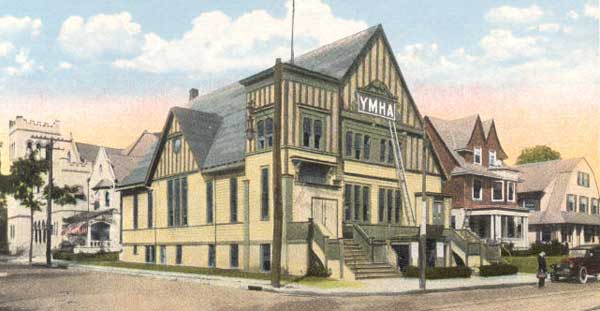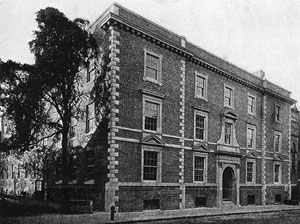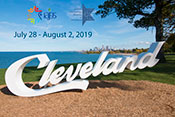The YM-YWHA of Paterson
(and later of North Jersey)

Over a hundred years ago, as early as 1877, the dream of a Jewish Center which would provide physical, social and educational activities for all ages took root in the minds of the Jews of Paterson. Many early attempts were unsuccessful.
In 1906, a handful of young women meeting regularly at the Barnert Free School formed the YWHA. In 1914, the YMHA was incorporated and rented quarters at 97 Broadway. A fierce desire grew among its founders to match the existing YMCA, which admitted some Jews but only under a quota system. The new YMHA proudly proclaimed "no quota here!"
In 1917, the United States declared war on Germany and the YMHA became a busy center of activity. A gym program was started at a neighboring school. Both the YWHA and the YMHA jointly and separately contributed to the war effort with dances, concerts and gift boxes for Jewish soldiers. During these years a popular joint venture was the Hebrew Literary and Debating Society.
When, in 1919, the YMHA moved to Orpheus Hall [pictured above], its activities multiplied. Athletics were in full swing; baseball and football leagues were organized which participated in state athletic meets. Numerous clubs were formed. A group of young men, the Culsos, founded to pursue culture, brought a lively literary, musical and social life to the "Y". A symphony orchestra was organized and concerts were presented at the Majestic Theater.
By 1922, the thriving YWHA had acquired a building on Church Street, and the YMHA was so vigorous that it was able to buy a lot on Van Houten Street next to Temple Emanuel and engage an executive director to publish a weekly newsletter, The Criterion. In December of that year, the YMHA and the YWHA formed one organization and prepared to move into a new home together (Jacob Fabian was honorary chairman of the new effort) -- a new Georgian-style building designed by Fred Wesley Wentworth on the former site of Temple Emanuel (which moved to a new building, also designed by Wentworth). The design was an institutional classical design of redbrick with granite ornamentation.
 |
The new building opened in 1925 and the "Y" became an important part of Paterson. The building included social halls, a gymnasium, swimming pool, auditorium, class rooms, meeting rooms, and a tiled rooftop which could be used for dances. The lobby had a snack bar and library of Judaica. For over fifty years, it was an active facility for clubs, dances, and social gatherings of all types. The physical education department flourished. A basketball team was formed and the baseball team won games throughout the state. Football, wrestling and track attracted numerous athletes and spectators. |
There was a surge of new members. Neighborhood organizations and dozens of clubs, junior and senior, began to meet at the "Y". Some of the clubs like the Culsos, the Panthers, the Roosevelt Club and the Hebrew Athletic Club became "lifetime clubs" lasting for more than thirty years. Tea dances were held where many young men and women met their future spouses. A lecture series was begun featuring nationally-known speakers.
In the late twenties the Religious Committee established a Sunday School and the "Y" offered regular Sabbath Services. These were eventually discontinued because they duplicated services offered by local synagogues and temples. In 1928, the partnership of the Veritans Club of Paterson and the "Y" was forged and Camp Vacation, a day camp, was created by the "Y" and supported by Veritans contributions.
Hard times during the depression brought out the best in the "Y". It became necessary to reduce staff and budget and increase the work load. In 1931, the new "Y" Woman's Club started its fundraising activities which continue to this day. They sponsored the Junior Lyceum program, a cultural arts program for teens. Through these rocky years another group, the Boosters, could be relied upon for fundraising. It supported activities and budgets and each year sponsored a special fundraising edition of The Criterion.
At this time, the Music Committee brought noted artists to Paterson and a special relationship with the Paterson community emerged when the "Y" concerts were moved to the larger auditorium at Eastside High School. Marian Anderson, Jascha Heifetz, Vladimir Horowitz, Yehudi Menuhin, Sergei Rachmaninoff, Artur Rubinstein and Efrem Zimbalist were only a few of the distinguished guests to perform.
December 7, 1941 plunged the nation into war and once again the "Y" met the challenge. It became the local headquarters for the home effort. It opened its doors 24 hours a day to military personnel stationed in or near Paterson. "Coffee and" was available along with social and athletic opportunities. Packages for Hanukkah and Passover were sent abroad and over 2,000 Jewish men in the armed forces were kept in touch through The Bugle, a newsletter prepared by The Criterion staff. Each man received an automatic membership in the "Y".
By the time the war ended the "Y" had lost many men on the battlefield.
With the return of the servicemen in 1945 and the arrival of refugees from Europe, the "Y" recognized the need for expansion. A generous gift of the old Temple Emanuel property next door to the "Y" enabled it to build an addition providing 30% more space for 'sorely needed facilities. New groups and new activities emerged. JONA, the Jewish Organization of New Americans, was formed; the Socialites, one of the first singles groups in New Jersey was started; the Junior Women's Club established the Cooperative Nursery School; and in the summer., of 1952 Camp Vacation became Camp Veritans where children of all economic backgrounds were served through a sliding scale of fees.
In 1966, the Anna L. Schneider Branch Building was offered to the "Y" through the Jewish Federation. Located outside of the downtown area with ample parking facilities, it opened new possibilities for junior and senior programs. The slogan of the Schneider Branch became "3 to 83".
Changes were taking place. Young people were leaving the city and new Jewish communities were springing up in the suburbs. In 1969, the membership chose a new name, the YM-YWHA of North Jersey. A search for a new location was under way.
The search for a new regional center for the YM-YWHA of North Jersey ended when in 1973 a site was found in Wayne on the Hinchman property [on Pike Drive]. Through the generous donations of a group of 14 long-time "Y" members who put together the seed money, 2.4 million dollars, the "Y" became a financial reality. The intense efforts of the Up-county Group, the tireless work of the Building Committee, and dynamic fundraising campaigns resulted in a center which would enrich the life of the Jewish communities for years to come.
On May 2, 1976 the YM-YWHA of North Jersey opened its doors [in Wayne] to serve people of all ages in the North Jersey communities. An atrium, art gallery, gift shop, theater, social hall, dance studio, Olympic-sized swimming pool, gymnasium with a suspended running track, health club, exercise rooms, several ball courts, coffee shop, meeting rooms, Judaica Library, numerous classrooms, senior lounge and tween and teen game room, The Jewish Federation of North Jersey, Jewish Family Service and the Jewish Board of Education are under the same roof.
The building on Van Houten Street designed by Wentworth is now used as the Norman Weir Public School.
In July 2011, with the crumbling economy and the looming threat of closing, the YM-YWHA announced a deal with the Metro YMCAs of the Oranges in Essex County that allowed the YM-YWHA to be kept open and provide unique services to the communinity. As of September 1, 2011, the Metro Y officially took control of the YM-YWHA of North Jersey. The Metro Y operates the day-to-day activities and runs the regular programs the YM-YWHA offers. And the YM-YWHA continuess to offer the Jewish celebrations and traditions the community has come to expect. Joyce Goldberg Fein, the interim director at the time, said that the membership was half Jewish and half non-Jewish.“I think most members use our facility for the fitness center and fitness classes, the swimming pool, and the gymnasium for our basketball court.... We also have a wonderful nursery school and people come for our cultural arts programs.” She added the teachers and instructors at the YM-YWHA are “thrilled that will be able to continue to offer our programs such as our summer day camp.” She said kids attending the summer day camp enjoy sports, classes in nature and cooking, as well as archery. She said the only difference is the food is kosher and every Friday the center celebrates a Shabbat.
Sources:
Jews of Paterson (2012), pp. 97-98
Our Paterson Jewish Heritage (1987), pp. 8-11
The Life & Times of Fred Wesley Wentworth (2012), p. 93
"YM-YWHA Joins Forces with the Metro YMCA of the Oranges" on The Wayne Patch, July 11, 2011

